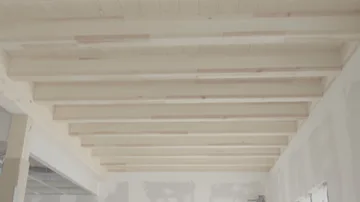At a time when the search for sustainability is in all areas of our lives, one of the solutions for efficiency in our homes we have it in banks of our rivers. Yes, the poplar, that tree that has accompanied us all our lives, turns out to be a super efficient wood for build sustainable houses. And there is already a house in the process of construction with this raw material.
We found it in the Vega de Granada. There, some of the poplars that characterize its landscape have been used to build a house very different from the usual ones. It is the first house to be built in Spain with laminated poplar wood.
Yolanda Requena, its owner, is clear about the benefits of choosing that construction. “It is sustainable, generates little waste and is built quickly“, he tells laSexta.
This future house, certified as ‘passive’ or passive houseis projected for have energy savings of up to 80%. “We are betting on building in a different way,” says Luis Llopis, architect of the studio that designed the home.
Passive houses are a standardized construction type in which its energy efficiency is optimized so that the house requires the minimum possible expenditure. The Passive House Institute (PHI) is the official body that certifies them.
The poplar, emblem of the Vega de Granada
In reality, this house is a small sample of a project major devised at the University of Granada and which seeks boost poplar wood.
“It is a wood that grows very fast“, has a great thermal insulation capacity and absorbs a lot of CO2,” says Antolino Gallego, professor at the University of Granada and coordinator of the European funding project. Life+ ‘Wood for the future’, funded by the EU. This Life seeks to recover the avenues of the Vega de Granada, Lorca landscape and cultural heritage of the area. In the last 20 years, the surface of poplar in the Vega de Granada has been reduced to be replaced by intensive agricultural crops. The rapid growth of poplar would allow the industry to have a raw material with greater continuity and give more value to the wood in the market.
In fact, the Andalusian Government wants to integrate it now for the construction of social housing in Granada. Precisely, that is the path that the EU wants to follow, which seeks for all newly built buildings to be climate neutral by 2030.

House built with poplar wood | the sixth
European regulations
These are the goals of the European Commission on buildings, according to the latest directive:
- All the new buildings They must be climate neutral from 2030.
- The new buildings occupied by Public authorities or that are their property must achieve this objective already in 2028.
- in buildings residentialcountries will have to take measures to reduce the average primary energy used by at least 16% by 2030 and at least 20-22% by 2035.
- Countries will be required to renovate the least efficient 16% of non-residential buildings by 2030 and the least efficient 26% by 2033 through minimum energy efficiency requirements.
Source: Lasexta
Ricardo is a renowned author and journalist, known for his exceptional writing on top-news stories. He currently works as a writer at the 247 News Agency, where he is known for his ability to deliver breaking news and insightful analysis on the most pressing issues of the day.











